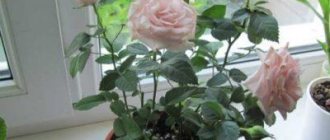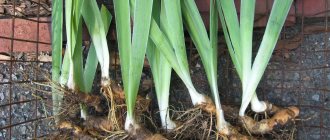Roses are rightfully considered the queens of flowers; their sophistication, tenderness and aroma do not leave anyone indifferent. A bouquet of roses is a win-win option for congratulations; what could be better than that? Only live, not cut roses. Recently, this option for a floral gift has become very popular and miniature roses in pots are the best gift option for any occasion. But what to do with them next, how to care for them so that they bloom and please the eye for a long time?
What are miniature roses
This is a group of varieties that are small in size, reaching no more than 40-50 cm in height. The bushes are quite spreading, with a lot of leaves. Their numerous flowers are usually small in size. Miniatures are most often sold in stores as gift or balcony roses. They can be grown in containers and used in the design of rooms, balconies, terraces, and festive decorations of the hall.
Miniature roses are also grown in gardens. They look great, for example, as low carpets or borders. Due to their small size, mini roses can be grown as indoor flowers. They have become a popular small gift that can be given on a variety of occasions such as name days, birthdays, anniversaries or simply as an expression of appreciation. Potted roses are more durable than cut flowers. Instead of just a few days, they will delight with their flowering for many months, and with proper care, even years.
Miniature roses sold by florists are often delayed in growth by special preparations. Therefore, they are much smaller (10-20 cm) than the same varieties when grown naturally. The effect of dwarfism lasts up to several months. In the following growing seasons, miniature roses reach normal sizes, that is, 40-50 cm. Their flowers and leaves are correspondingly larger.
This is not the only surprise that can happen with a small rose bush received as a gift. Sometimes these roses also change colors. For example, in the first months they are red, and in subsequent seasons they are orange. This is also the effect of using special drugs. The natural color in the described case is orange. The red color is the result of treatments aimed at making the rose attractive for sale.
It is worth remembering that a rose is a shrub adapted to life in the open air and it needs winter dormancy at low temperatures. Therefore, it is difficult to grow a rose on a windowsill in an apartment for years, although it is theoretically possible.
Description and features
Types of dwarf crops
Bengal
This species was brought to Europe from Bengal, which is why it got its name. The Bengal rose bush grows 40-50cm in height. The leaves are pointed, dark green. The shape of the flowers is slightly flattened, and their color can be red, white or pink.
Teahouse
Tea rose was brought from China. Its aroma is reminiscent of tea, which is why it got its name. There is another version - its blossoming flowers resemble the shape of a Chinese tea bowl. The bush of this rose grows 50cm. The leaves are dark green. have an oval shape. The flowers are double, large, and their colors can be very different.
This species has a long flowering period. This is the only type of rose from which tea can be made.
Mix
The bush of this interesting type of dwarf roses looks like a ready-made bouquet. They are not classified into varieties for sale, which is why they are called that. It comes in miniature (up to 30cm) and patio (up to 50cm). She comes in a variety of colors. Flowers are medium sized, flattened.
You can learn more about the varieties of the lovely mixed rose and the features of its cultivation here.
Polyanthus
It is also called multi-flowered. It can reach a height of up to 50 cm. The flowers are small, double or semi-double, and have no scent. The flowers are collected in inflorescences and are distinguished by a variety of color shades.
Botanical description
Belongs to the Rosaceae family. Most often, dwarf roses are evergreen multi-stemmed shrubs, the height of which varies from 10 to 50 cm. The leaves are alternate, compound, with stipules, each of which contains 5-13 oval or round leaflets. The surface of the leaves can be shiny or matte, their color is usually dark green.
The stems of most types of dwarf roses are covered with thorns. The diameter of flowers can be from 1 to 5 cm. Flowers can be single, double or semi-double. Their shape can be spherical, flat, goblet or cupped. The shape of the petals can also be different: they can be bent, flat or wavy. Dwarf roses can be of all colors and shades, there are not only blue ones.
Peculiarities
The main feature of miniature roses is their small size. Another feature is that this species is suitable for growing both indoors and outdoors. The size of mini roses makes it convenient to grow them at home, and due to their frost resistance, they are also suitable for open ground.
Another distinctive feature of these roses is that they make excellent decorations for borders, verandas and attics, again due to their small size.
Pros and cons of growing miniature species in pots at home
The benefits of growing miniature roses at home include:
- decorativeness;
- long flowering period;
- variety of colors and shades;
- resistance to diseases and pests.
The disadvantages of growing mini roses at home include:
- dwarf roses are more whimsical than ordinary ones;
- small sizes (not everyone likes this).
Origin story
The history of the origin of dwarf roses is not entirely clear. You can find several versions of the origin of the species in different sources: some of them say that the flower’s homeland is Europe, others believe that it was brought from Southeast Asia. But according to the classical version, it is believed that the miniature rose was brought from China.
Diseases
Are there dark spots on the shoots of the rose? This could be necrosis, find out how to save the plant
Bark necrosis on roses
Does the rose begin to wither and die for no apparent reason? It could be root rot, find out control and prevention measures
Root rot of roses
Girdle spots of brick and burgundy shades appear on the shoots of roses, find out why this happens
Infectious rose burn
Are there growths and cracks on the rose? It could be cancer, read what to do next
Common rose cancer
If you received a miniature rose as a gift or bought one from a flower shop, place it in a well-lit place, but not in direct sunlight, “East” or “Southeast” is best. When placed on the south side, during the day they need to be shaded from the scorching sun.
- Choosing a pot. For the shortest varieties, growing up to 35 cm, a pot with a height of 20-30 cm is sufficient. For larger ones, you need to take a pot of about 50 cm, but for all plants it is important that each pot has a hole in the bottom, as well as a drainage layer (pebbles , expanded clay, coarse gravel). This will prevent the roots of the roses from standing in water, which is very harmful for them. The pot should be large, preferably with double walls (they protect against excessive freezing and heating of the soil and drying out). It is better to plant miniature roses outdoors no later than August. Thanks to this, they will gradually go into a dormant state - they will become woody, stop blooming and shed their leaves. In addition, they will take root better before winter.
- Substrate selection. Miniature roses purchased in the store are already planted in special substrates with the addition of long-lasting fertilizers. Such substrates dry out quite quickly, so you need to take care of systematic watering. Since the volume of the pot is small, the nutrients run out quite quickly. Therefore, roses should be replanted in fresh soil and larger pots. They tolerate this procedure very well during flowering. For planting and replanting roses, it is best to use a specialized substrate; it must be fertile, preferably with humus, light, breathable and slightly acidic. Proper pH (pH 5.4-6.2) ensures proper growth, lush flowering and greater disease resistance.
- Transfer time. It is best to replant roses 3-4 weeks after purchase, but here you need to take into account the time of year, because miniature roses are sold all year round, including in winter. Of course, the winter months are not the best time for roses to bloom in our climate. These are specimens grown in greenhouse conditions. Therefore, it is better to postpone their transplantation until the turn of winter and spring. In winter, bushes are replanted solely when necessary, for example, when the root ball has grown so large that it “crawls out” of the pot and dries out very quickly.
- Watering. The rose loves moderate but constant humidity, so we water it often, but not too much. The water in the pan should not stagnate.
If possible, it is best to transplant a miniature rose into the garden. It would also be a good idea to place it on the balcony.
Growing roses in apartments is more difficult because in winter they are too warm and dry. As a result, roses do not “go to sleep” for the winter, which makes them weaker and more often affected by diseases and pests. If possible, provide them with rest in a cool area, such as an unheated room. It is better for them to spend the summer outside, for example, on a balcony or terrace.
Why indoor miniature roses dry out and how to prevent this you will learn from the video.
Errors, consequences and their correction
Problems when growing mini roses at home can also arise due to improper care. What problems could these be?
- The plant does not develop or grow. The cause may be poor nutrition. To eliminate the problem, you need to regularly feed the flower.
- Leaves are falling. The reason is increased soil acidity. The problem can be solved by liming the soil.
- The leaves turn yellow and wither. Have you noticed this problem in your plant? This means he doesn't have enough light! Choose a well-lit area, and use additional lighting in the form of lamps in winter.
- The rose doesn't bloom. The fact is that you haven’t replanted your rose for a long time! Although she doesn't like it, this procedure needs to be done every 2 years.
A rose bush can be a wonderful decoration not only in the garden, but also in the house. On our website you will find articles about such types of indoor roses as Cordana and learn how to grow a bush rose in a pot.
A miniature rose is a great option for decorating your home. The variety of colors and types allows you to make a choice among its many varieties. Of course, it is quite difficult to care for it, but the result of your labors will not be long in coming - your flower will delight you with its flowering for a long time.
How to fertilize miniature roses
Florists provide ideal conditions for flowers. When preparing plants for sale, they are planted in specially prepared soil, which contains enough nutrients for several weeks. In order for them to continue to actively bloom and not lose their decorative effect for a long time, they need to be periodically fed with fertilizers. Lack of nutrition immediately affects the general condition of the rose, their leaves become smaller, turn pale, and flowering weakens.
Miniature roses are fertilized every two weeks from spring to August. The best fertilizers are those that are formulated specifically for roses. For miniatures planted in pots, liquid preparations are most convenient, for example “Fasco Flower Happiness”. Its cap is also a dispenser. The measured dose is poured into a watering can and watered over the rose.
Long-lasting fertilizers are also very convenient. For example, it is enough to apply Kemira Universal fertilizer once in the spring. It comes in the form of granules, the ingredients of which are released gradually, depending on humidity and temperature.
It is very convenient to use drugs in capsules, for example Magic Grow. This drug contains nutrients and a growth activator. Simply break off the tip of the self-distributing applicator and stick it into the substrate. A specially selected composition ensures lush flowering of plants and healthy leaves for two months. The flowers have a rich color.
Basic care for garden dwarf roses
Miniature garden roses are not considered capricious species. The key to the correct development of the plant, its lush and long-lasting flowering is proper care and the correct planting site.
To avoid possible mistakes, pay attention to the following important nuances:
- The place for roses should be well protected from wind and drafts;
- Loamy, slightly acidic soil is suitable for miniature beauties;
- Stagnant water and waterlogging are extremely undesirable; be sure to prepare good drainage to drain excess moisture;
- The distance between bushes should not be less than 25 cm;
- The optimal time for planting them is the end of April. Over the summer and autumn, the plant will strengthen well in the soil, build a powerful root system, which will minimize losses during the winter period;
- To avoid freezing, it is better to cover dwarf roses for the winter with spruce branches, straw or spandbond;
- Watering dwarf roses is carried out as the soil dries, best in the evening. It is extremely undesirable to overflow water and dry out the soil;
- It is very important to carry out complex mineral and organic fertilizing of roses. In the spring, preparations with a high content of nitrogen and potassium are added, which contribute to the active growth of vegetative mass and the formation of buds. Autumn feeding is aimed at the full ripening of young shoots and strengthening the root system before the cold weather. The basis of the feeding complex is phosphorus and potassium with a small percentage of nitrogen;
- The plant is pruned after wintering, removing all frozen branches, leaving three buds per shoot.
An effective organic fertilizer in spring is rotted manure, which is placed in furrows at a distance of 25 cm from the base of the bush.
How and when to water roses in pots
The intensity of watering potted roses must be adapted to their growth phase. When they sprout and bloom, the substrate should be kept slightly moist at all times. From the end of summer, they are gradually preparing for a state of winter dormancy, so you need to reduce the intensity of watering to a very economical one. In winter, the substrate in the pot should be almost dry. Tap water can be used for irrigation. If it is very hard, it is recommended to filter it, for example, in a kitchen jug.
Miniature roses transplanted into open ground are watered from time to time when the soil dries out excessively.
When watering, you should not spray the leaves, as this promotes the development of fungal diseases.
Popular varieties
There are more than a hundred varieties of miniature roses in different shades. The most popular in the Moscow region are the following:
- Bonika 82 (pale pink);
- Danica (snow white);
- Garnetfroide (raspberry red);
- Magic Madland (magenta);
- Medeo (white, not double flowers);
- Sunny Rose (light yellow).
Groups of dwarf roses from the Palace series (polyanthus roses with large double flowers), Victory (the height of the bush is only 18-20 cm, and the diameter of the flower is up to 8 cm), and Pagoda (an ampelous rose with a bouquet type of flowering and an apple aroma) are suitable for indoor growing.
Sources:
https://babushkinadacha.ru/cvety/rozy-miniatyurnye-opisanie-i-vyrashhivanie-v-sadu.html https://flo.discus-club.ru/miniatyurnye-rozy.html https://3vedra.com/ cvety/miniatyurnye-rozy.html
How to store miniature roses in winter
Miniature roses need a winter rest to grow healthy and bloom profusely. They winter poorly in heated apartments, where it is difficult to provide them with adequate winter rest. Weakened plants are very often attacked by spider mites and fungal diseases. As a result, they either dry out or are in very poor condition.
Therefore, you should avoid wintering miniature roses in apartments. It is safer for them to overwinter, for example, in an unheated room or garage with a window. A balcony is also suitable for them. However, then the pot should be placed on a board or polystyrene foam and covered, for example, with cardboard. The surface of the ground should be covered with materials such as bark or deoxidized garden peat. The above-ground part of the rose is covered with fabric or agrofibre.
If the rose was planted in the garden, it should be covered with a mound of earth for the winter.
Miniature roses have different frost resistance. But if you don’t know the exact name of the variety, it’s impossible to check what the lowest temperature it can withstand. Therefore, it is better to protect all miniatures from frost if they spend the winter outside, that is, on the balcony or in the garden.
Care and cultivation
Caring for miniature roses is not difficult, but requires strict adherence to the regime of watering, fertilizing and pest control treatments.
Watering and fertilizing
In the first couple of weeks, after planting the seedlings in the ground, water the plants every 2 days. The rose's root system is actively growing, and moisture is vital for the flower. Further watering can be reduced to weekly. The exception is in hot weather, then blooming roses are watered every 3-4 days.
Roses in containers need moisture more than those growing in the ground, since the soil dries out faster in an enclosed space. An excellent way to get rid of the daily running around with a watering can is to install automatic drip irrigation.
Water for watering roses should not be cold or hard. Tap water is allowed to settle for a couple of days. But it is better to use rain or river water.
Watering is carried out in the evenings, directing a stream from a hose or watering can under the bush of the plant. Leaves and flowers do not moisturize.
Preventative treatment of the rosary
Among the insect pests that are not averse to feasting on the foliage and tender shoots of a miniature rose, the following are especially dangerous: aphids, sawfly larvae, spider mites, and leafhoppers. It is necessary to regularly inspect the rose garden to identify pests in order to begin combating them in time.
Aphid. Small light-colored insects, in large colonies, cling to young shoots of roses and the underside of leaves. Often, an aphid invasion can be associated with the appearance of a colony of ants near the affected plants. The pest feeds on the sap of the plant, inhibiting it. The rose grows and blooms poorly and may die in winter.
Control and prevention measures:
- April spraying of bushes with Actellik, Karbofos;
- in summer, the affected plants are treated with a soap solution (40 g of green soap per 10 liters of water) every week until the pest disappears.
Cicada. The female pest lays eggs in the young shoots of roses in the fall. In spring, the larvae feed on plant sap. The affected rose weakens and drops its leaves.
Control: early spring spraying of the rose garden with insecticides at intervals of 2 weeks.
Spider mite. It is especially dangerous in greenhouses and conservatories, where it can multiply rapidly. The color of the insect is reddish or yellow, the length of the body is only half a millimeter. The tick overwinters in the top layer of soil, under leaves and mulch.
The pest feeds on plant sap, entwining the underside of leaves and young shoots with a web. Dry air in a greenhouse promotes mite development.
Prevention and control:
- autumn cleaning of leaves and mulch from the garden;
- increasing air humidity to 70%;
- spraying plants with acrex, isophene.
Sawfly. The pest overwinters in the soil. Insects damage rose shoots by gnawing tunnels in them. The presence of a pest can be determined by the drying apical shoots of the plant.
Control and prevention:
- digging up the soil under rose bushes in the fall, before frost;
- damaged shoots are cut out and burned;
- In early spring, the rose garden is sprayed with Karbofos.
Diseases of miniature roses
In rainy and cool weather, if plants are planted close together and there is poor air circulation between them, roses may suffer from powdery mildew or downy mildew. A whitish coating forms on the shoots, leaves and buds, gradually covering the entire plant.
Affected bushes must be destroyed. If the infection is weak, pruning the diseased parts of the bush will help. For prevention, twice a year, in spring and autumn, the rose garden is sprayed with 3% copper sulfate or a mixture of iron sulfate and potassium sulfate. It is useful to incorporate wood ash into the soil in the fall, 1 cup per 1 square meter. meter.
Rust attacks the stems of roses, appearing as bright orange spots on the plant. The disease spreads during rainy summers. The fight against the disease consists of removing the affected parts and treating the rose garden with Bordeaux mixture in the autumn.
If there is a lack of iron, zinc, magnesium, boron in the soil, rose leaves turn white or yellow, then dry out. This disease is called chlorosis. Feeding plants with necessary microelements will help eliminate the problem.
Propagation and pruning
Mini roses do not produce shoots, so they are propagated by cuttings. Summer cuttings are practiced, when branches with 2-3 buds are cut from a bush in June. The branches are cut obliquely, preventing the tissue from being soaked.
The cuttings are dusted with Kornevin and immersed in containers filled with a mixture of peat and sand. Place a plastic bag on top of the container. Cuttings take root at a temperature of +24 degrees and a humidity of 70-80%, within a month. Then they can be transplanted into soil or a large container for further growing. The substrate is prepared from a mixture of peat, sand and humus, adding complex mineral fertilizer for roses.
Dwarf roses must be pruned annually, removing weak and old branches. In the first year after planting, each branch is shortened to 3-4 buds. This pruning stimulates the growth of branches in different directions.
In the future, the haircut is carried out every spring until the buds open. Pruning miniature roses is similar to pruning patterns for hybrid tea plants.
How to cover for the winter
The main principle of covering a mini rose is breathability and dryness inside. Excess moisture combined with low air temperatures threatens the flower with rotting and death.
With the onset of negative temperatures at the level of -2...-3 degrees, the bushes are covered with peat, sawdust (shavings) or earth to a height of 15 cm.
Frames made of wooden blocks or wire are installed above them; wooden boxes can be used.
Lutrasil or other breathable material is placed over the frame, and the shelter is covered with spruce branches.
In spring, the coverings from the rose garden are gradually removed, preventing the plants from becoming damp or freezing.
When and how to prune miniature roses
Small roses are always pruned in the spring - at the turn of March and April. First of all, you should remove all dried and broken shoots. Trim the rest at a height of 3-5 buds. Pruning is necessary to ensure that roses branch correctly and bloom profusely. During the growing season, it is also worth trimming faded flowers. This simple procedure guarantees the constant appearance of new flower buds and the flowering period is extended. You can use pruning shears or flower scissors to trim bushes.
Planting a dwarf border beauty
The main factor in growing is properly selected soil.
. Slightly acidic loams are best suited.
To create favorable conditions for a flower, you need to follow some recommendations:
- dry sandy soil is dug up with 2-3 buckets of clay and humus;
- on damp and clayey soils, on the contrary, add a mixture of humus and sand;
- also add 400 grams of lime to the planting hole;
- 500 grams of dolomite flour;
- 50 grams of superphosphate;
- 200 grams of wood ash.
If precipitation or melt water accumulates on the site, drainage is required.
Miniature roses are planted only in early spring so that the root system has time to strengthen before the onset of cold weather.
During work, plants are buried 3-5 centimeters into the soil
. Immediately after planting, small bushes are covered with non-woven material to protect them from the bright sun.
Rose varieties for growing in containers
There are many varieties of roses that can be grown on a balcony, patio or in an apartment, but miniature roses are best suited for such purposes. They are no higher than 30-40 cm, have a compact growth and take up little space. There are many varieties of this species. The most compact: Mandy, Pepita, Roxy, Apricot Clementine, Charmant or Zwergenfi.
If we have more space, we can grow large-flowered varieties up to 50 cm. We recommend Aladdin Palace or Samba, as well as ground cover roses: Meidrifora, Meigalpio or Purple Rain.
Varieties
The color of the petals is varied: from greenish Green Ice to bluish Lavander Jewel, and in height you will find small ones 15-25 cm, and real giants up to 1 m. This species has become the most popular in the USA and Canada . Today, hundreds of varieties have been bred. Some breeders also include the patio rose
, exceeding them in size (the new group belongs to the floribunda). Let's look at a miniature view by color:
Red: Bonaparte, Red Cascade, Caribia, Cordula, maid, Minima, Noble Heat, Media, Orange Jewel, Zwergkeing, Starina, Charming Parade.
Two-color: Stars & Stripes, Baby Maskarade, Green Ice Min, Hummingbird, Debut, Coraline, Lavender Jewel, Meirov, Neomi, Over the rainbow, Rosemary , Mimi Eden, Star-n-Stripes, Apricot Sun-blaze, Magic Carrousel Min.
White: Daniella, Mini White, Pixie, Jack Frost.
Pink: Daniella Min, Pink Symphony Min, Pirouette, rolls, Eleanor, chipper, Carol Emling, Bella Rosa, Memory Hit.
Yellow: Yellow Doll, Gene Kenneally, Corco, Golden Meyandino, Little Leamming Min, Rainbow and Juliet, Golden Meyandino, Goldie Cordan.
Corco
A compact, low-growing bush (up to 40 cm) has glossy, dark green leaves. The flowers are bright, yellow-orange, round, double, collected in racemes. It blooms quite profusely in early summer. Ideal for potted culture, in the foreground of a mixborder or rose garden, to create borders and rugs, along paths.
Juliet
Mini bush 25-30 cm in height. It has dark, small, dense leaves 2-3 cm. The flowers are round, 1.5 - 2.5 cm in diameter, densely double, lemon-yellow in color. Great for plantings in pots and borders.
Mimi Eden
A branched bush 40 -50 cm in height, has a small number of thorns on the shoots, with matte, small leaves. The buds are soft pink, slowly blooming in 5-20 pieces. in inflorescence. The petals are small, and the outer side is white with a green tint, and there is more pink in the middle. There is a faint aroma. Winter-hardy variety. Suitable for growing in containers, flower beds, lawns, foregrounds and borders.
Miniature roses are inexpensive to purchase; their price is the same as for polyanthus varieties. I think each of you can buy a miniature variety, since it will be affordable.
Now you know everything about cheerful miniature roses and you will not have any difficulties in growing them.
Basic recommendations for growing miniature roses
Let us briefly summarize all the above material and highlight the main points for growing small rose bushes.
- Selection of plants - in the store we choose a rose that has few flowers but many buds. Green leaves with no signs of damage or disease.
- The place is sunny, protected from rain and spacious. We shade the plants from the scorching midday rays. Remember that wet leaves + lack of free air access = fungal diseases.
- Pot - for mini roses - approx. 30 cm, for taller ones (up to 1m) - min. 50-60 cm. Be sure to have a hole at the bottom and a drainage layer.
- The soil is fertile, humus, well-drained, slightly acidic. Always slightly damp. Water frequently, but with a small amount of water.
- Top dressing - from March to the end of July with multi-component fertilizers for flowering plants.
- Removing faded flowers - use pruning shears to cut off the inflorescence along with a piece of shoot to the eye above the first leaf.
- Wintering - preferably a dark and cool room (0-5 o C). On the balcony, polystyrene foam is placed under the pot and covered with agrotextile. Watering during thaw.
- March - pruning, replanting if necessary.
If you follow these simple recommendations, your roses will delight you for many years with abundant and long-lasting flowering.
Watch a video on how to grow and care for roses in pots.
Reproduction
Reproduction is carried out only by cuttings
according to the following scheme:
- To carry out the work, choose powerful stems with 3-4 buds.
- Next, make a cut at an angle of 45 degrees under the bud from below, and at a right angle above the bud from above.
- The finished cuttings are kept in Epin solution (100 grams per liter of water) for 8-10 hours.
- First, drainage is laid out at the bottom of the container, then fertile garden soil is poured. At the final stage, a thin layer of sand is added.
- Then the cuttings are rooted, moistened abundantly and covered with film. They are kept in this state for a month.
As soon as the first roots appear, future seedlings can be opened and ventilated.











